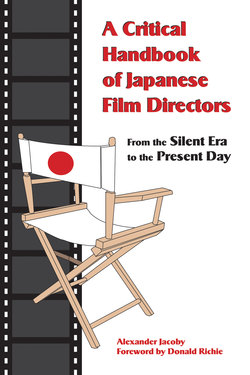Читать книгу A Critical Handbook of Japanese Film Directors - Alexander Jacoby - Страница 21
HANI Susumu
Оглавление(b. October 10, 1928)
羽仁進
If Imamura was the anthropologist of the Japanese New Wave, then Hani was its sociologist. During the nineteen-sixties, his subtle, probing films explored many of the social issues confronting postwar Japan, including the gap between rich and poor, the role of women in society, the alienation of youth, and the country’s relations with the outside world. His early documentaries, made for Iwanami Productions, focused particularly on children and paved the way for his first feature, Bad Boys (Furyō shōnen, 1960), a low-key study of the lives of juvenile delinquents in a reformatory. With its use of amateur actors and location shooting in a real reformatory, it seemed as much neo-realist as New Wave. Its non-judgmental approach would prove typical of Hani, who was to return to the theme of life in a community of children in Children Hand in Hand (Te o tsunagu kora, 1964), an engaging remake of a 1948 Hiroshi Inagaki film which observed teaching methods and the relations between schoolfellows in a progressive school.
Meanwhile, in A Full Life (Mitasareta seikatsu, 1962) and She and He (Kanojo to kare, 1963), Hani crafted intricate miniatures of Japanese society, focused through the attempts of independent women to find meaning in life. The former linked its heroine’s struggle for personal emancipation with the political campaign against the U.S.-Japan security treaty. The latter examined the growing disparity between rich and poor through its portrait of the relationship between a middle-class woman, her husband, and a local ragpicker living in the slums adjacent to their modern apartment block. A detailed examination of the attitudes of the prosperous towards the poor and the gulf between bourgeois and working class morality, this was also a penetrating psychological study of the motivation behind one woman’s compulsive desire to do good. Hani’s most famous film abroad, the powerful Inferno of First Love (Hatsukoi: Jigoku hen, 1968), was more purely
psychological in its concerns, tracing the roots of an adolescent boy’s impotence to the trauma of childhood sexual abuse. Adolescent psychology was likewise the subject of Morning Schedule (Gozenchū no jikanwari, 1972), an incoherent experimental film whose failure marked the end of Hani’s regular feature film production.
Hani is a rare case of a Japanese director who has worked successfully abroad: Bride of the Andes (Andesu no hanayome, 1966) was shot in Peru, Mio (Yōsei no uta, 1971) in Sardinia, and The Song of Bwana Toshi (Buwana Toshi no uta, 1965) and Africa Story (Afurika monogatari, 1980) in Kenya. Of these, Bwana Toshi and Bride of the Andes were intriguing studies of culture clash: in the former, the Japanese hero, posted to Africa, learns gradually to cooperate with the locals in building a house, while the latter was about a mail-order bride who goes to marry an archaeologist stationed in a tribal village. Both films explored the way in which the experience of being an expatriate impels people to self-definition and also implicitly criticized Japan’s insular mentality.
Although Inferno of First Love expressed its hero’s psychological traumas through visual pyrotechnics typical of the New Wave, Hani’s style was generally more restrained than those of such contemporaries as Nagisa Ōshima, Shōhei Imamura, and Masahiro Shinoda. His gently probing, often handheld camera observed his characters with sympathetic detachment: Bad Boys neither condemned, nor approved of, the actions of its juvenile delinquents, while The Song of Bwana Toshi extended the same placid curiosity to the Japanese hero, his African colleagues, and the animals of the savannah. Often, Hani’s actors improvised scenes, a method taken to its extreme in Morning Schedule, where the actors themselves collaborated on shooting 8mm footage which was incorporated into the final film. With his semi-documentary approach, it was not surprising that Hani eventually came to specialize in wildlife documentaries for television. The curtailment of his career in feature filmmaking is to be regretted, for his sixties films rank among the most humanly engaging products of the Japanese New Wave.
1952 Seikatsu to mizu / Life and Water (short)
1953 Yuki matsuri / Snow Festival (short)
Machi to gesui / The Town and Its Drains (short)
1955 Kyōshitsu no kodomotachi / Children in Class (short)
1956 E o kaku kodomotachi / Children Who Draw (short)
Sōseiji gakkyū / Twin School (short)
1957 Dōbutsuen nikki / Zoo Diary (short)
1958 Umi wa ikiteiru / The Sea Is Alive (short)
Hōryū-ji / Horyu-ji (short)
1960 Furyō shōnen / Bad Boys
1962 Mitasareta seikatsu / A Full Life
1963 Kanojo to kare / She and He
1964 Te o tsunagu kora / Children Hand in Hand
1965 Bwana Toshi no uta / The Song of Bwana Toshi
1966 Andesu no hanayome / Bride of the Andes
1968 Hatsukoi: Jigoku hen / Inferno of First Love / Nanami: First Love
1969 Aido / Aido: Slave of Love
1970 Koi no daibōken / Love’s Great Adventure
1971 Yōsei no uta / Mio (lit. The Fairy’s Song)
1972 Gozenchū no jikanwari / Morning Schedule
1980 Afurika monogatari / Africa Story
1982 Yogen / Prophecy
1983 Rekishi = Kakukyōran no jidai / History: Age of Nuclear Madness
